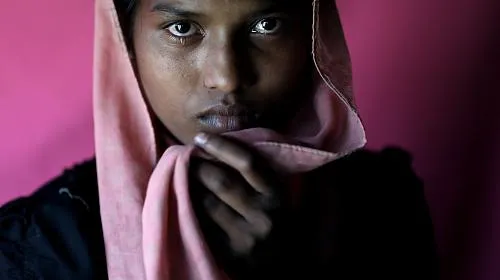AMMAN, Jordan (Oct. 9, 2018) — Amid an unprecedented global refugee crisis, girls are suffering the most, according to a new report released on International Day of the Girl by the humanitarian organization CARE. Titled ‘Far from Home: The 13 Worst Refugee Crises for Girls,’ the report highlights not only the unique threats faced by the more than 17 million girls displaced globally but also the inspiring ways girls are overcoming those barriers. The Syria conflict leads the list, followed by displacement crises in the Horn of Africa, Afghanistan, South Sudan and the Lake Chad Basin.
“What’s one of the most dangerous things to do in the world? Be a girl in a refugee crisis,” says Michelle Nunn, president and CEO of CARE. “Girls are strapped with explosives and turned into human bombs in Nigeria, married off at alarming rates in Yemen and subjected to sexual violence in conflicts from South Sudan to Myanmar. On International Day of the Girl, we must recognize that reality, work to change it and celebrate the inspirational girls who, though far from home, are far from helpless.”
CARE’s report highlights the stories of girls such as Walaa, an aspiring Syrian filmmaker who is telling her own family’s refugee story, and Marwa, who was once forced into child labor in Jordan but now has a chance to attend school and pursue her dreams. CARE is urging its supporters to sign a petition and call on lawmakers to protect U.S. foreign assistance that saves lives and equips girls with the tools they need to overcome the threats routinely faced in emergencies.
In concert with International Day of the Girl’s official UN theme this year — empowering girls in crisis — the multimedia report lists the worst refugee crises for girls that have started or grown worse since the UN created that special day for girls 6 years ago. The crises are ranked in order of total girls displaced, both across national borders as refugees and within their countries as internally displaced people, or IDPs. Read the report and share it at care.org/farfromhome.
The statistics are startling. CARE has found that as many as two-thirds of women and girls have suffered physical or sexual violence in conflict-ravaged areas of South Sudan. Girls are 2.5 times more likely to be out of school in conflict-affected countries than their counterparts in conflict-free countries. And in Northeast Nigeria, Boko Haram is four times more likely to deploy girl bombers than boys. Meanwhile, early marriage rates have soared during the war in Yemen: now more than two-thirds of Yemeni girls are married off before they turn 18.
“The epidemic of human displacement is the great humanitarian challenge of our time, and girls are bearing the brunt,” Nunn said. “They are strong and courageous, and on International Day of the Girl we must remind ourselves to help them overcome some of the most difficult circumstances on Earth.”
About CARE Founded in 1945 with the creation of the CARE Package®, CARE is a leading humanitarian organization fighting global poverty. CARE places special focus on working alongside poor girls and women because, equipped with the proper resources, they have the power to lift whole families and entire communities out of poverty. Last year CARE worked in 93 countries and reached 63 million people around the world. Learn more at care.org.
Media Contacts: Media interviews with CARE’s experts and video/photo assets are available by contacting Nicole Harris at Nicole.Harris@care.org, 404-735-0871; or Brian Feagans at Brian.Feagans@care.org or 404-457-4644.

